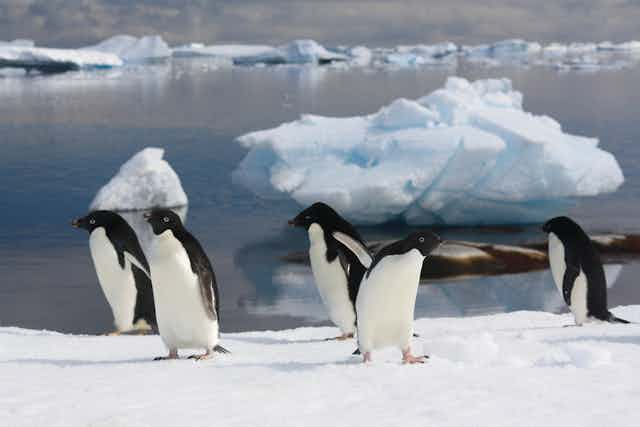Penguin numbers exploded in East Antarctica at the end of the last ice age, according to research published today in BMC Evolutionary Biology. Despite their image as cold-loving creatures, the increase in Adélie penguin numbers seems to be closely linked to shrinking glaciers, raising the possibility the these penguins could be winners from current climate change.
Adélie penguins are one of only two penguin species that live on the Antarctic continent. Their cousins, emperor penguins, may be the movie stars, but it is the Adélies that are the bigger players in the Southern Ocean. They outnumber emperors by more than ten to one, with a population of over 7.5 million breeding adults and counting.
Given the abundance of Adélie penguins and their crucial role in Southern Ocean ecosystems, there has been a great deal of interest in understanding how the species is likely to respond to future climate change.

Sensitivity to sea ice
Breeding colonies have been monitored for decades to determine the effects of a changing environment on the penguins. A common finding of many of these studies is that Adélies are highly sensitive to sea ice conditions.
Unlike emperor penguins, Adélies do not nest on the sea ice, but they must cross it to reach their nests on land. As everyone knows, penguins are not the most efficient walkers, and in years with a lot of sea ice their journeys to and from the ocean to feed their chicks can become lengthy. With a longer wait between meals chicks are less likely to survive.
In an extreme case, extensive sea ice at one breeding colony had a devastating impact in 2014, and not a single chick survived.
Based on these observations over years and decades, there has been concern that changing sea ice conditions, including increases in certain parts of Antarctica, could have a serious impact on Adélie penguin numbers in the future.
Short-term vs long-term climate change
However, the climate change that is taking place now is not a decadal trend. Rather, the shrinking glaciers and ice sheets, changing sea ice conditions, and shifting currents and weather patterns represent a global change to a new climate.
We therefore set out to understand how Adélie penguins in East Antarctica were affected by the last big shift to a different climate: the ending of the last ice age.
Following similar methods to our previous study on emperor penguins, we used genetic data to uncover the trend of the Adélie population in East Antarctica over the past 22,000 years.

The end of the ice age
We found that, as for the emperor penguins, Adélies were far less common during the ice age. This is not at all surprising since most of their nesting sites would have been covered with glaciers and their feeding grounds encased in sea ice that never melted.
Following the end of the ice age 20,000 years ago, temperatures increased slowly, and after a few thousand years of warming the glaciers and ice sheets began to shrink. Fast forward to 10,000 years ago and the annual sea ice melting cycle that we see today was established.
Given the sensitivity of Adélie penguins to sea ice changes today, we predicted that Adélie numbers would remain very small until 10,000 years ago when sea ice conditions became similar to what they are now.
However, the penguins surprised us again. We found that the number of Adélies exploded by around 135-fold, but the expansion pre-dated the sea ice change by at least 3000 years.

Shrinking glaciers
The proliferation of Adélie penguins in East Antarctica began during a period of ice sheet and glacier retreat, which would have increased the amount of ice-free ground available for nesting.
A study of Adélie penguins at the Scotia Arc, on the opposite side of the continent, found that numbers in this region rose 17,000 years ago. That expansion was several thousand years before the growth of the East Antarctic population, but coincided with the shrinking of glaciers in the Scotia Arc. This lends further support to our conclusion that it was glacier retreat, rather than changing sea ice conditions, that caused the hike in Adélie penguin numbers after the last ice age.
This is an important finding, as it suggests that the effects of climate change on a species over thousands of years can be quite different to the effects over years or decades. Given the long-term nature of contemporary climate change, we suggest that it is critical to consider millennial-scale trends alongside decadal ecological studies when predicting the effects of climate change on a species.
Could penguins benefit from future climate change?
Glaciers and ice sheets in Antarctica will continue to shrink. As this happens, ground that was previously covered in ice will become suitable for Adélie penguin nesting. In regions with adequate food supplies and where sea ice conditions remain favourable, Adélie penguin numbers may continue to grow.
A recent study using satellite images showed that one breeding colony in the Ross Sea grew by 84% between 1983 and 2010, as a direct result of a glacier shrinking by 543 m and uncovering new nesting sites.
While it seems that East Antarctic Adélie penguins might come out on top as climate change winners, it is important to keep in mind that for penguins to flourish their food supplies must be plentiful enough to meet the demands of a growing population. Whether this will be the case in the future remains to be seen, as Adélie penguin prey species, such as Antarctic krill, are threatened by both climate change and commercial fisheries.

